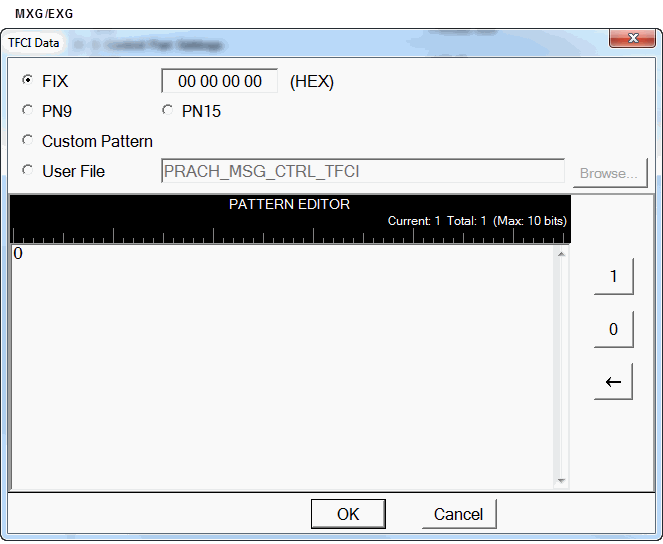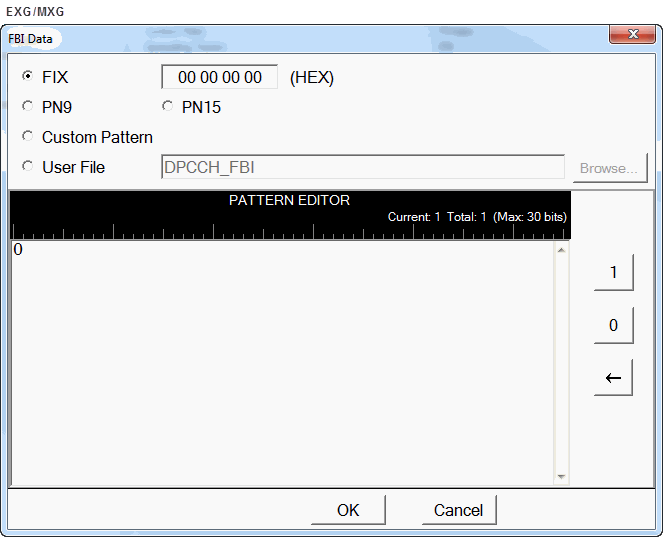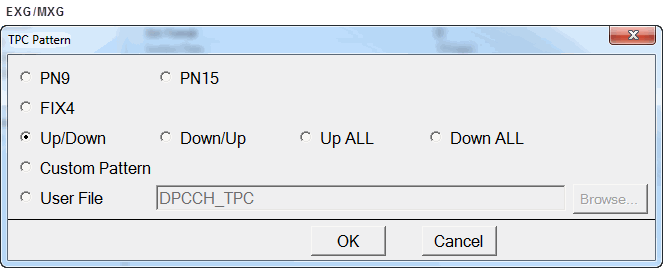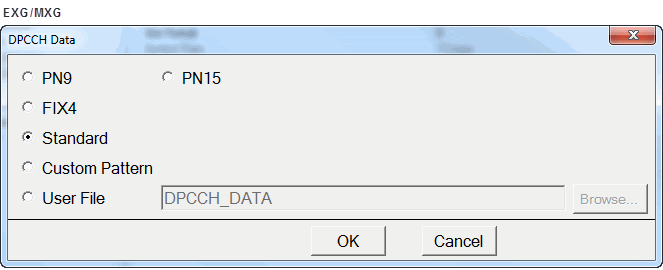DPCCH
The Dedicated Physical Control Channel (DPCCH) transmits the connection-mode signaling and control to the UEs.
|
1. DPCCH |
2. DPCCH Data |
|---|---|
|
|
|
|
|
|
|
|
|
|
|
|
|
|
|
|
|
|
|
|
|
|
|
|
|
|
|
|
|
|
|
|
|
|
|
DPCCH Configuration Summary Table
This section defines the Settings Current and Apply Needed buttons. Only one button is available at any time. These buttons are available in all of the W-CDMA/HSPA+ Uplink's tree nodes.
|
|
This button indicates that the current real-time settings have been applied to the instrument. No action is required. |
|
This button indicates that the instrument settings are not current and need to be updated to be applied to the instrument. Click this button to update the instrument's settings. [:SOURce]:RADio:WCDMa:TGPP[:BBG]:ULINk:APPLy [:SOURce]:RADio:WCDMa:TGPP[:BBG]:ULINk:APPLy? |
1. DPCCH
State
Choice: Off | On
Default: On
Enables or disables the DPCCH state.
[:SOURce]:RADio:WCDMa:TGPP[:BBG]:ULINk:DPCCh[:STATe] ON|OFF|1|0
[:SOURce]:RADio:WCDMa:TGPP[:BBG]:ULINk:DPCCh[:STATe]?
Power
Range: –40 to 0 dB
Default: –2.69 dB
Enter the DPCCH power level in dB.
If the parameter set by the following command is changed while the signal is active, the :ULINk:APPLy command or Apply Needed ( ) button must be executed for the change to occur.
) button must be executed for the change to occur.
[:SOURce]:RADio:WCDMa:TGPP[:BBG]:ULINk:DPCCh:POWer <val>
[:SOURce]:RADio:WCDMa:TGPP[:BBG]:ULINk:DPCCh:POWer?
Channel Code
Range: 0 to 255
Default: 0
Sets the channel code of DPCCH. This field is enabled when only the DPCCh and/or DPDCH state are set to On. Indicates the calculated channel code of DPCCH when other channel states are set to On.
If the parameter set by the following command is changed while the signal is active, the :ULINk:APPLy command or Apply Needed ( ) button must be executed for the change to occur.
) button must be executed for the change to occur.
[:SOURce]:RADio:WCDMa:TGPP[:BBG]:ULINk:DPCCh:CCODe <val>
[:SOURce]:RADio:WCDMa:TGPP[:BBG]:ULINk:DPCCh:CCODe?
Slot Format
Range: 0 to 5
Default: 0
Sets the slot format of DPCCH.
If the parameter set by the following command is changed while the signal is active, the :ULINk:APPLy command or Apply Needed ( ) button must be executed for the change to occur.
) button must be executed for the change to occur.
[:SOURce]:RADio:WCDMa:TGPP[:BBG]:ULINk:DPCCh:SLOTformat <val>
[:SOURce]:RADio:WCDMa:TGPP[:BBG]:ULINk:DPCCh:SLOTformat?
Symbol Rate
Indicates the Symbol Rate (symbol per second: sps) for DPCCH. This value is fixed to 15 ksps.
[:SOURce]:RADio:WCDMa:TGPP[:BBG]:ULINk:DPCCh:RATE?
Spreading Factor
Indicates the Spreading Factor for DPCCH. This parameter is not editable.
TFCI State
Displays the TFCI State. This state is not editable and linked to the value of the DPCCH Slot Format.
[:SOURce]:RADio:WCDMa:TGPP[:BBG]:ULINk:DPCCh:TFCI[:STATe]?
TFCI State
TFCI Data
Choice: PN9 | PN15 | FIX | Custom Pattern | User File
Default: FIX [10-bit] (0)
FIX Range: 0 to 1023 (0x3FF), Default: 0
Edit the TFCI Data for the dedicated physical control channel (DPCCH) on the cell. Then click on the dialog box icon  to launch the
to launch the  TFCI Data dialog box.
TFCI Data dialog box.
Opens a that sets the Transport format combination indicator for DPCCH.
When loading a user file through the software's Data dialog box, the MXG/EXG requires an ASCII text file consisting of 1s and 0s. When using SCPI commands, all instruments require a binary data file.
|
Custom Pattern |
Sets the E-DPCCH data pattern to Custom Pattern. The value of this command is a string which is represented ‘0’ or ‘1’. The maximum data length is 10 patterns. |
|
User File |
This variable specifies a data pattern that has been stored in memory. |
If the parameter set by the following command is changed while the signal is active, the :ULINk:APPLy command or Apply Needed ( ) button must be executed for the change to occur.
) button must be executed for the change to occur.
[:SOURce]:RADio:WCDMa:TGPP[:BBG]:ULINk:DPCCh:TFCI:PATTern PN9|PN15|FIX|PATTern|"<filename>"
[:SOURce]:RADio:WCDMa:TGPP[:BBG]:ULINk:DPCCh:TFCI:PATTern?
If you select PATTern or FIX, use the following commands to create the pattern:
[:SOURce]:RADio:WCDMa:TGPP[:BBG]:ULINk:DPCCh:TFCI:PATTern:FIX <val>
[:SOURce]:RADio:WCDMa:TGPP[:BBG]:ULINk:DPCCh:TFCI:PATTern:FIX?
[:SOURce]:RADio:WCDMa:TGPP[:BBG]:ULINk:DPCCh:TFCI:PATTern:PATTern <val>
[:SOURce]:RADio:WCDMa:TGPP[:BBG]:ULINk:DPCCh:TFCI:PATTern:PATTern?
FBI State
Displays the DPCCH FBI state. This state is not editable and linked to the value of the DPCCH Slot Format.
[:SOURce]:RADio:WCDMa:TGPP[:BBG]:ULINk:DPCCh:FBI[:STATe]?
FBI Data
Choice: FIX | PN9 | PN15 | Custom Pattern | User File
Default: FIX [30-bit] (0x00000000)
FIX Range: 0 to 0x3FFFFFFF, Default: 0
Edit the FBI pattern (30-bit) for the dedicated physical control channel (DPCCH) by clicking on the cell. Then click on the dialog box icon  to launch the
to launch the  FBI Data dialog box.
FBI Data dialog box.
When loading a user file through the software's Data dialog box, the MXG/EXG requires an ASCII text file consisting of 1s and 0s. When using SCPI commands, all instruments require a binary data file.
If the parameter set by the following command is changed while the signal is active, the :ULINk:APPLy command or Apply Needed ( ) button must be executed for the change to occur.
) button must be executed for the change to occur.
[:SOURce]:RADio:WCDMa:TGPP[:BBG]:ULINk:DPCCh:FBI:PATTern PN9|PN15|FIX|PATTern|"<filename>"
[:SOURce]:RADio:WCDMa:TGPP[:BBG]:ULINk:DPCCh:FBI:PATTern?
If you select PATTern or FIX, use the following commands to create the pattern:
[:SOURce]:RADio:WCDMa:TGPP[:BBG]:ULINk:DPCCh:FBI:PATTern:FIX <val>
[:SOURce]:RADio:WCDMa:TGPP[:BBG]:ULINk:DPCCh:FBI:PATTern:FIX?
[:SOURce]:RADio:WCDMa:TGPP[:BBG]:ULINk:DPCCh:FBI:PATTern:PATTern <val>
[:SOURce]:RADio:WCDMa:TGPP[:BBG]:ULINk:DPCCh:FBI:PATTern:PATTern?
TPC Pattern
Choice: PN9 | PN15 | FIX4 | Up/Down | Down/Up | Up All | Down All | Custom Pattern | User File
Default: Up/Down
Edit the TPC pattern by clicking on the cell. Then click on the dialog box icon  to launch the
to launch the  TPC Pattern dialog box.
TPC Pattern dialog box.
The increase/decrease direction for UE power level changes is determined by the transmit power control (TPC) pattern.
When loading a user file through the software's Data dialog box, the MXG/EXG requires an ASCII text file consisting of 1s and 0s. When using SCPI commands, all instruments require a binary data file.
If the parameter set by the following command is changed while the signal is active, the :ULINk:APPLy command or Apply Needed ( ) button must be executed for the change to occur.
) button must be executed for the change to occur.
[:SOURce]:RADio:WCDMa:TGPP[:BBG]:ULINk:DPCCh:TPC:PATTern PN9|PN15|FIX4|UDOWn|DUP|UALL|DALL|PATTern|"<filename>"
[:SOURce]:RADio:WCDMa:TGPP[:BBG]:ULINk:DPCCh:TPC:PATTern?
If you select <"filename">, PATTern or FIX4, use the following commands to create the pattern:
[:SOURce]:RADio:WCDMa:TGPP[:BBG]:ULINk:DPCCh:TPC:PATTern:FIX4 <val>
[:SOURce]:RADio:WCDMa:TGPP[:BBG]:ULINk:DPCCh:TPC:PATTern:FIX4?
[:SOURce]:RADio:WCDMa:TGPP[:BBG]:ULINk:DPCCh:TPC:PATTern:PATTern <val>
[:SOURce]:RADio:WCDMa:TGPP[:BBG]:ULINk:DPCCh:TPC:PATTern:PATTern?
Number of Steps
Choice: 1 to 80
Default:1
Sets the number of steps for increasing/decreasing the user's equipment (UE) power.
If the parameter set by the following command is changed while the signal is active, Play must be executed for the change to occur.
[:SOURce]:RADio:WCDMa:TGPP[:BBG]:ULINk:DPCCh:TPC:NSTeps <val>
[:SOURce]:RADio:WCDMa:TGPP[:BBG]:ULINk:DPCCh:TPC:NSTeps?
TPC Pattern Trigger State
Choices: On | Off
Default: Off
Enables or disable the TPC Patter Trigger State.
[:SOURce]:RADio:WCDMa:TGPP[:BBG]:ULINk:DPCCh:TPC:PATTern:TRIGger[:STATe] OFF|0
[:SOURce]:RADio:WCDMa:TGPP[:BBG]:ULINk:DPCCh:TPC:PATTern:TRIGger[:STATe]?
2. DPCCH Data
DPCCH Data
Choice: PN9 | PN15 | FIX4 | Standard | Custom Pattern | User File
Default: Standard
Edit the data pattern for the dedicated physical control channel (DPCCH) by clicking on the cell. Then click on the dialog box icon  to launch the
to launch the  DPCCH Data dialog box.
DPCCH Data dialog box.
When loading a user file through the software's Data dialog box, the MXG/EXG requires an ASCII text file consisting of 1s and 0s. When using SCPI commands, all instruments require a binary data file.
If the parameter set by the following command is changed while the signal is active, the :ULINk:APPLy command or Apply Needed ( ) button must be executed for the change to occur.
) button must be executed for the change to occur.
[:SOURce]:RADio:WCDMa:TGPP[:BBG]:ULINk:DPCCh:DATA PN9|PN15|FIX4|STD|PATTern|"<filename>"
[:SOURce]:RADio:WCDMa:TGPP[:BBG]:ULINk:DPCCh:DATA?
If you select <"filename">, PATTern or FIX4, use the following commands to create the pattern:
[:SOURce]:RADio:WCDMa:TGPP[:BBG]:ULINk:DPCCh:DATA:FIX4 <val>
[:SOURce]:RADio:WCDMa:TGPP[:BBG]:ULINk:DPCCh:DATA:FIX4?
[:SOURce]:RADio:WCDMa:TGPP[:BBG]:ULINk:DPCCh:DATA:PATTern <val>




